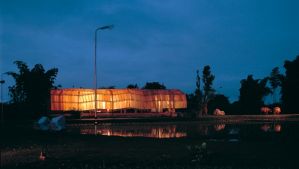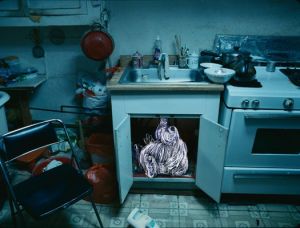Philippe Parreno, Serpentine Gallery | reviews, news & interviews
Philippe Parreno, Serpentine Gallery
Philippe Parreno, Serpentine Gallery
Enter the 'unreal' world of the French artist in his first UK solo show
Lovers of the beautiful game may already be familiar with the name Philippe Parreno, or at least with his best-known work. In 2006 he collaborated with artist Douglas Gordon (24-hour Psycho) on Zidane: A 21st-Century Portrait, a film that trained 17 cameras on the footballing genius for the duration of a game. Following Zidane’s every move, the 90-minute feature proved an especially intimate portrait: the cameras stayed close, never straying, never hinting at the 80,000 strong crowd nor bringing the other players into view. Zidane, who was also miked up, appeared oblivious to the intense scrutiny of the multiple lenses; it was a portrayal of a man utterly, unselfconsciously focused on what he was doing.
Parreno, an Algerian-born Frenchman who now lives in Paris, has spent most of his career producing work in collaboration with fellow artists, musicians, curators, film-makers and animators. But the Serpentine exhibition is his first solo show in the UK. This might, perhaps, be something of a surprise for such an international art star, yet you will almost certainly leave this exhibition feeling that Parreno’s moment might just have finally arrived.
 The exhibition comprises three short films (I’ve since learned that there is in fact a further film that greets you as you enter the gallery, though on my visit I had to do without the footage of kids demonstrating in a playground with placards bearing the slogan “No More Reality") and each, in its own way, is also a portrait: the first of an empty building project situated by a lake in Thailand (pictured above right), the second of a small Chinese immigrant boy in New York, and the third of a brief historical moment – the re-enactment of the train journey that took Robert Kennedy’s body from New York to Washington DC in 1968. All are hauntingly atmospheric.
The exhibition comprises three short films (I’ve since learned that there is in fact a further film that greets you as you enter the gallery, though on my visit I had to do without the footage of kids demonstrating in a playground with placards bearing the slogan “No More Reality") and each, in its own way, is also a portrait: the first of an empty building project situated by a lake in Thailand (pictured above right), the second of a small Chinese immigrant boy in New York, and the third of a brief historical moment – the re-enactment of the train journey that took Robert Kennedy’s body from New York to Washington DC in 1968. All are hauntingly atmospheric.
It’s worth noting here the name Darius Khondji, who can be thanked for the impressive, at times breathtaking cinematography. This is especially noteworthy in the second film, which plays on a huge, multiplex-sized screen viewed from only a couple of dozen feet away; so in terms of the precedence of the artist, a solo show, yes, but a collaborative effort all the same, yielding an utterly memorable visual experience.
We begin with what sounds like the overwhelming, violent chatter of crickets as The Boy From Mars, 2003, opens (there is no boy, and this is not a sci-fi movie, though there’s an interesting play between ideas of the primitive and timeless and the futuristic). The violent chirruping is, in fact, the frantic clatter of the building's exterior panels being whipped by strong wind. The building, a long, slug-shaped tent that forms part of a self-sustaining artists’ collective, glows brightly like a lantern in the night, its image reflected by the still lake nearby. We see oxen attached to pulleys that are attached to generators; filmed in disorienting close-up, these strong, slow, stoic creatures are the only living, breathing beings we encounter.
 June 8, 1968, 2009 (pictured left) invites us on a train journey, which, though it re-enacts the journey transporting Robert Kennedy’s body from New York to Washington, is actually filmed in lush, verdant California. Inspired by the photographs of Paul Pasco, who took pictures of the procession route from the actual train, Parreno’s elegiac but quietly unnerving film is also shot from the interior of a slow train. A fictive portrayal of an America in bewildered mourning, we sense something here of the palpably uncanny. The breathtaking verdance of the hills, upon which a scattering of people stand as still as statues against the intense blue of the sky in the closing shot suggests something close to hyper-reality.
June 8, 1968, 2009 (pictured left) invites us on a train journey, which, though it re-enacts the journey transporting Robert Kennedy’s body from New York to Washington, is actually filmed in lush, verdant California. Inspired by the photographs of Paul Pasco, who took pictures of the procession route from the actual train, Parreno’s elegiac but quietly unnerving film is also shot from the interior of a slow train. A fictive portrayal of an America in bewildered mourning, we sense something here of the palpably uncanny. The breathtaking verdance of the hills, upon which a scattering of people stand as still as statues against the intense blue of the sky in the closing shot suggests something close to hyper-reality.
 Invisibleboy, 2010 (main picture and right) is Perrano’s most recent film and is one that the artist hopes to make into a longer feature. A “docu-fantasy”, if such a category can be imagined, it’s a sinister, dream-like tale of an illegal Chinese immigrant boy who sees imaginary monsters, which are scratched onto the film stock. These scratched-out, ominous apparitions pulsate like visible electric currents, an effective metaphor, perhaps, for the dangerous, wired-up, out-of-control energy of the city itself which vibrates to a thudding rock soundtrack.
Invisibleboy, 2010 (main picture and right) is Perrano’s most recent film and is one that the artist hopes to make into a longer feature. A “docu-fantasy”, if such a category can be imagined, it’s a sinister, dream-like tale of an illegal Chinese immigrant boy who sees imaginary monsters, which are scratched onto the film stock. These scratched-out, ominous apparitions pulsate like visible electric currents, an effective metaphor, perhaps, for the dangerous, wired-up, out-of-control energy of the city itself which vibrates to a thudding rock soundtrack.
The exhibition is a completely immersive experience, not just visually, but polyphonically, too, for as one film finishes you’re led to the next through an orchestrated sequence of sounds. Speakers are strategically placed behind screens so that sounds are located exactly at their points of origin on the screen. In fact, sound and image impact with equal force and as well as the internal sounds in the gallery, noise from Kensington Gardens is transmitted inside, the odd, disorientating conversation filtering through and mingling with the film score. When the final film finishes, the blinds slowly rise, the light floods in and one sees a flurry of snow outside and the mist of hot breath on the window panes. What a strangely beguiling, magical, but slightly discomforting, "unreal" experience all this proves to be.
- Philippe Parenno at Serpentine Gallery until 13 February, 2011
- Find Zidane: A 21st-Century Portrait on Amazon
Explore topics
Share this article
more Visual arts
 Fantastic Machine review - photography's story from one camera to 45 billion
Love it or hate it, the photographic image has ensnared us all
Fantastic Machine review - photography's story from one camera to 45 billion
Love it or hate it, the photographic image has ensnared us all
 Yinka Shonibare: Suspended States, Serpentine Gallery review - pure delight
Weighty subject matter treated with the lightest of touch
Yinka Shonibare: Suspended States, Serpentine Gallery review - pure delight
Weighty subject matter treated with the lightest of touch
 Jane Harris: Ellipse, Frac Nouvelle-Aquitaine MÉCA, Bordeaux review - ovals to the fore
Persistence and conviction in the works of the late English painter
Jane Harris: Ellipse, Frac Nouvelle-Aquitaine MÉCA, Bordeaux review - ovals to the fore
Persistence and conviction in the works of the late English painter
 Sargent and Fashion, Tate Britain review - portraiture as a performance
London’s elite posing dressed up to the nines
Sargent and Fashion, Tate Britain review - portraiture as a performance
London’s elite posing dressed up to the nines
 Zineb Sedira: Dreams Have No Titles, Whitechapel Gallery review - a disorientating mix of fact and fiction
An exhibition that begs the question 'What and where is home?'
Zineb Sedira: Dreams Have No Titles, Whitechapel Gallery review - a disorientating mix of fact and fiction
An exhibition that begs the question 'What and where is home?'
 Yoko Ono: Music of the Mind, Tate Modern review - a fitting celebration of the early years
Acknowledgement as a major avant garde artist comes at 90
Yoko Ono: Music of the Mind, Tate Modern review - a fitting celebration of the early years
Acknowledgement as a major avant garde artist comes at 90
 Unravel: The Power and Politics of Textiles in Art, Barbican review - the fabric of dissent
An ambitious exploration of a neglected medium
Unravel: The Power and Politics of Textiles in Art, Barbican review - the fabric of dissent
An ambitious exploration of a neglected medium
 When Forms Come Alive, Hayward Gallery review - how to reduce good art to family fun
Seriously good sculptures presented as little more than playthings or jokes
When Forms Come Alive, Hayward Gallery review - how to reduce good art to family fun
Seriously good sculptures presented as little more than playthings or jokes
 Entangled Pasts 1768-now, Royal Academy review - an institution exploring its racist past
After a long, slow journey from invisibility to agency, black people finally get a look in
Entangled Pasts 1768-now, Royal Academy review - an institution exploring its racist past
After a long, slow journey from invisibility to agency, black people finally get a look in
 Barbara Kruger, Serpentine Gallery review - clever, funny and chilling installations
Exploring the lies, deceptions and hyperbole used to cajole, bully and manipulate us
Barbara Kruger, Serpentine Gallery review - clever, funny and chilling installations
Exploring the lies, deceptions and hyperbole used to cajole, bully and manipulate us
 Richard Dorment: Warhol After Warhol review - beyond criticism
A venerable art critic reflects on the darkest hearts of our aesthetic market
Richard Dorment: Warhol After Warhol review - beyond criticism
A venerable art critic reflects on the darkest hearts of our aesthetic market
 Dineo Seshee Raisibe Bopape: (ka) pheko ye / the dream to come, Kiasma, Helsinki review - psychic archaeology
The South African artist evokes the Finnish landscape in a multisensory installation
Dineo Seshee Raisibe Bopape: (ka) pheko ye / the dream to come, Kiasma, Helsinki review - psychic archaeology
The South African artist evokes the Finnish landscape in a multisensory installation

Add comment